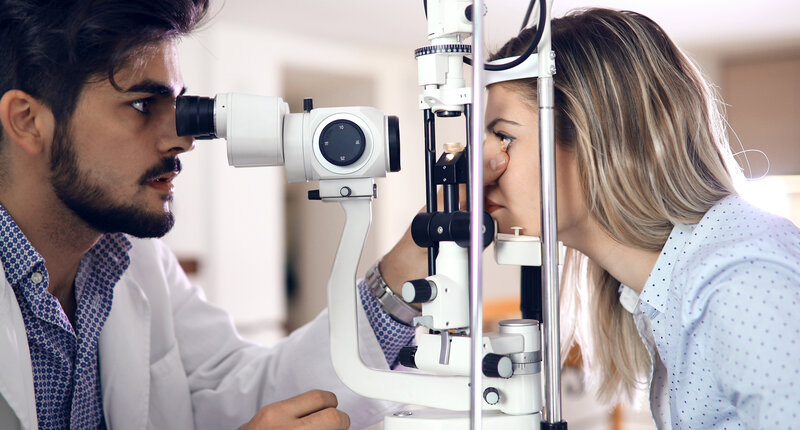Schedule Eye Exams To Monitor Effects Of High-Risk Meds

Medication side effects run the gamut, with the most common being upset stomach, headaches, changes in energy, or dry mouth. However, some relatively common medications cause side effects that can negatively affect the health of your eyes and vision. Make sure to share all of your medication prescriptions and supplement lists with your optometrist.
We’ll know if any of them pose a risk to your vision, and it may mean increasing the frequency of eye exams so we can keep a lookout for any changes or symptoms of side effects. We refer to these as “an exam for high-risk medications” or a high-risk med exam.
Do You Take Any Of These High-Risk Meds?
Here are some of the medications that pose the highest risk to your eyes. But, again, we encourage you to bring a list of current prescriptions and supplements to each and every one of your eye exams. It’s easy to forget you started a new medication, but we can’t take care of you the way you deserve without the right information.
We’ll review your medications and let you know if any of them are considered “high-risk” regarding your vision. You should schedule an exam immediately if you experience any eye discomfort or compromised vision symptoms associated with your medications.
Here are some of the medications that increase the risk of eye or vision issues.
Alendronate (Fosamax)
This medication is prescribed for patients who are high-risk or are showing the signs of osteoporosis. It increases the body’s ability to absorb calcium and build denser, stronger bone tissue. It is taken once per week.
Patients who take Fosamax have a high risk of experience eye pain, blurred vision, and conjunctivitis.
Isotretinoin (Accutane, Absorica)
Isotretinoin is the active medication in some acne medications. This means teens need to know the potential risks and pay attention to their eyes. If your teen passes the school vision test, that’s great! However, if s/he is not getting annual comprehensive vision exams, it’s time to schedule one - especially if s/he takes Accutane or Absorica.
Side effects from this medication include dry eyes, inflamed eyelids (blepharoconjunctivitis), and light sensitivity. Teens are already at risk for dry eyes due to their continuous and excessive use of screen technology. Your teen may also develop a sensitivity or inability to wear their contact lenses.
Topiramate (Topamax)
Created to treat seizures, Topamax is also be prescribed to treat migraines and mood disorders. Unfortunately, patients using Topamax have higher rates of glaucoma, which can cause blurred vision, eye pain, and headaches. The increased pressure in the eye might also lead to dilated pupils.
Tamsulosin (Flomax)
Flomax is a first-line treatment for men with benign, enlarged prostate glands. However, it can lead to severe complications while having cataract surgery. The condition is called intraoperative floppy iris syndrome (IFIS), or a “blown iris.”
If your physician recommends Flomax and you think you might have cataract surgery at some point, ask for alternative treatment options. Studies have shown that ceasing the medication before surgery does not change the risk, so you’re elevating that risk down the road once you take it.
Sildenafil (Viagra)
One of the most common treatments for erectile dysfunction (ED), Viagra, is prescribed for about 20 million Americans each year. Unfortunately, similar medications like Cialis and Levitra post the same risks of side effects, including blurred vision, altered color perception, eye pain, and extreme light sensitivity. These complications are most likely at higher doses, and they disappear if patients stop taking the meds.
Amiodarone (Cordarone)
Patients with atrial fibrillation may use Cordarone to regulate heart rhythms. However, those on higher doses are the most likely to experience eye problems such as seeing haloes around lights, bright light sensitivity, glare issues, dry eyes, and hazy vision.
Tamoxifen
Tamoxifen blocks the body’s estrogen production and treats certain forms of breast and ovarian cancer fed by estrogen. It can make the cornea more opaque or reduce vision by diminishing peripheral vision or creating holes in your central vision. It’s best to schedule an eye exam within the first year of taking Tamoxifen to look out for any potential vision issues.
Hydroxychloroquine (Plaquenil)
Forms of hydroxychloroquine treat a range of diseases. This includes auto-immune disorders like rheumatoid arthritis and lupus, as well as malaria. Your physician may prescribe Plaquenil as a prophylactic medication for travelers spending time in countries or regions with a higher risk of contracting malaria.
Side effects from this medication can affect your eyes, including deposits in the cornea and retina toxicity. If you’re taking a form of hydroxychloroquine to treat an autoimmune disorder, your optometrist will want to see you more regularly. If you take the medication for a shorter duration due to travel, consider scheduling an eye exam when you return.
Celecoxib (Celebrex)
Celebrex and another COX-2 inhibitor, meloxicam, relieve pain and inflammation. Typically, Celecoxib is prescribed for patients with rheumatoid arthritis, osteoarthritis, or patients with acute inflammatory pain. The medication increases the risk of blurred vision and conjunctivitis. Symptoms reverse once patients go off the meds.
Ethambutol and Isoniazid
This antibiotic duo is proscribed to treat tuberculosis (TB). Fortunately, this is far less common in the United States than in other countries. However, patients treating TB with these medications may experience inflammation to the optic nerve (optic neuritis) that can cause permanent damage if untreated, changes in color perception, and visual field defects such as gaps or a loss of central or peripheral vision.
Regular Eye Exams To Monitor Your Eyes & Vision
Are you or a family member taking one of these high-risk medications? Schedule a high-risk medication exam with us at Eye to Eye Family Vision Care, and we’ll make sure to monitor your eyes and vision, so we can treat any potential risks before they do permanent damage.

